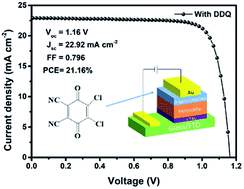Strong electron acceptor additive based spiro-OMeTAD for high-performance and hysteresis-less planar perovskite solar cells†
Abstract
As the most popular hole-transporting material (HTM), spiro-OMeTAD has been extensively applied in perovskite solar cells (PSCs). Unluckily, the pristine spiro-OMeTAD film has inferior conductivity and hole mobility, thus limiting its potential for application in high-performance PSCs. To ameliorate the electrical characteristics of spiro-OMeTAD, we employ 2,3-dichloro-5,6-dicyano-1,4-benzoquinone (DDQ) as a strong electron acceptor into spiro-OMeTAD in PSCs. The incorporation of DDQ with spiro-OMeTAD not only improves the conductivity and the Fermi energy level, but also reduces the trap states and nonradiative recombination, which accounts for the remarkable enhancement in both the fill factor (FF) and open-circuit voltage (VOC) of PSCs. Consequently, the champion PSC with DDQ doped hole transport layer (HTL) generates a boosted power conversion efficiency (PCE) of 21.16% with an FF of 0.796 and a VOC of 1.16 V. Remarkably, DDQ modified devices exhibit superb device stability, as well as mitigated hysteresis. This study provides a facile and viable strategy for dopant engineering of HTL to realize highly efficient PSCs.



 Please wait while we load your content...
Please wait while we load your content...